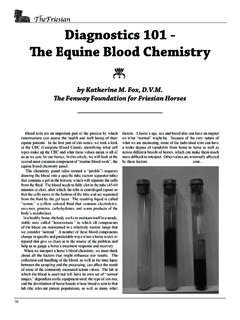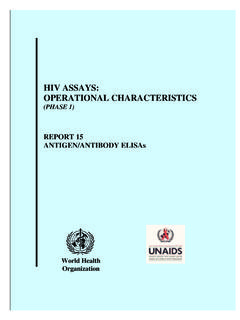Transcription of Section 33. Programming and Diagnostics
1 2007-2012 Microchip Technology 33-1 Programming and Diagnostics33 Section 33. Programming and DiagnosticsHIGHLIGHTSThis Section of the manual contains the following .. in Power-Saving Modes .. of Application Notes .. 33-15 PIC32 Family Reference ManualDS61129F-page 33-2 2007-2012 Microchip Technology INTRODUCTIONThe PIC32 family of devices provides a complete range of Programming and diagnostic featuresthat can increase the flexibility of any application using them. These features allow systemdesigners to include: Simplified field Programming using 2-wire In-Circuit Serial Programming (ICSP ) interfaces Debugging using standard ICSP and Enhanced ICSP Programming and debugging capabilities using the Enhanced Joint Test Action Group (Enhanced JTAG) extension of Joint Test Action Group (JTAG) interfaces JTAG Boundary scan testing for device and board diagnosticsThe PIC32 family of devices incorporates two Programming and diagnostic modules, and a tracecontroller, which provide a range of functions to the application developer (see Figure 33-1).
2 They are summarized in Table 33-1:Block Diagram of Programming , Debugging and Trace PortsNote:This family reference manual Section is meant to serve as a complement to devicedata sheets. Depending on the device variant, this manual Section may not apply toall PIC32 consult the note at the beginning of the Special Features chapter in thecurrent device data sheet to check whether this document supports the device youare data sheets and family reference manual sections are available fordownload from the Microchip Worldwide Web site at: :Not all Programming and diagnostic features are available on all devices. Refer tothe specific device data sheet for 33-1:Comparison of PIC32 Programming and Diagnostic FeaturesFunctionsPins UsedInterfaceBoundary ScanTDI, TDO, TMS and TCK pinsJTAGP rogramming and Debugging TDI, TDO, TMS and TCK pinsEnhanced JTAGP rogramming and DebuggingPGECx and PGEDx pinsICSP TDITDOTCKTMSJTAGC ontrollerICSP ControllerCoreInstruction TraceControllerPGEC1 PGED1 PGECxPGEDxTRCLKTRD0 TRD1 TRD2 TRD3 2007-2012 Microchip Technology 33-3 Section 33.
3 Programming and DiagnosticsProgramming and OPERATIONThis Section provides a brief overview of operation for each Programming option. For detailedinformation, refer to the PIC32MX Flash Programming Specification (DS61145). Also, for alldevice Programming options, a minimum VDD requirement for Flash erase and programmingoperations is required. Refer to the specific device data sheet for further Programming IN-CIRCUIT SERIAL Programming (ICSP )ICSP is Microchip s proprietary solution to providing microcontroller Programming in the targetapplication. ICSP is also the most direct method to program the device, whether the controller isembedded in a system or loaded into a device ICSP InterfaceICSP uses two pins as the core of its interface.
4 The Programming data line (PGD) functions asboth an input and an output, allowing Programming data to be read in and device information tobe read out on command. The Programming clock line (PGC) is used to clock in data and controlthe overall PIC32 devices have more than one pair of PGECx and PGEDx pins, which are multiplexedwith other I/O or peripheral functions. Individual ICSP pin pairs are indicated by number, such asPGEC1/PGED1, and so on. The multiple PGECx/PGEDx pin pairs provide additional flexibility insystem design by allowing users to incorporate ICSP on the pair of pins that is least constrainedby the circuit design. All PGECx and PGEDx pins are functionally tied together and behave iden-tically, and any one pair can be used for successful device Programming .
5 The only limitation isthat both pins from the same pair must be addition to the PGECx and PGEDx pins, ICSP requires that all voltage supply (including thevoltage regulator pin, ENVREG) and ground pins on the device must be connected. The MCLRpin, which is used with the PGECx pin to enter and control the Programming process, must alsobe connected to the typical ICSP connection is shown in Figure 33-2:Typical ICSP ConnectionICSP PIC32 VSSVDDMCLRPGECxPGEDxVSSVDDMCLRCLKData I/OPIC32 Family Reference ManualDS61129F-page 33-4 2007-2012 Microchip Technology ICSP OperationICSP uses a combination of internal hardware and external control to program the target data and instructions are provided on the PGD.
6 ICSP uses a special set ofcommands to control the overall process, combined with standard PIC32 instructions to executethe actual writing of the program memory. The PGD also returns data to the external programmerwhen responding to of the Programming process is achieved by manipulating the PGC and MCLR. Entry intoand exit from Programming mode involves applying (or removing) voltage to MCLR whilesupplying a code sequence to the PGD and a clock to the PGC. Any one of the PGECx/PGED xpin pairs can be used to enter Programming . The internal process is regulated by a state machine built into the core logic of PIC32 devices;however, overall control of the process must be provided by the external Programming Programming devices, such as the MPLAB PM 3 (used with MPLAB IDE software),include the necessary hardware and algorithms to manage the Programming process for PIC32devices.
7 Users who are interested in a detailed description, or who are considering designingtheir own Programming interface for PIC32 devices, should refer to the PIC32MX FlashProgramming Specification (DS61145). ENHANCED ICSPThe Enhanced ICSP protocol is an extension of the standard version of ICSP. It uses the samephysical interface as the original, but changes the location and execution of Programming controlto a software application written to a PIC32 device. Use of Enhanced ICSP results in a significantdecrease in overall Programming ICSP uses a simple state machine to control each step of the Programming process;however, that state machine is controlled by an external programmer.
8 In contrast, EnhancedICSP uses an on-board bootloader, known as the program executive, to manage theprogramming process. While overall device Programming is still controlled by an externalprogrammer, the program executive manages most of the tasks that must be directly controlledby the programmer in standard program executive implements its own command set, wider in range than standard ICSP,that can directly erase, program and verify the device program memory. This avoids the need torepeatedly run ICSP command sequences to perform simple tasks. As a result, Enhanced ICSPis capable of Programming or reprogramming a device faster than standard program executive is not preprogrammed into a PIC32 device.
9 If Enhanced ICSP is needed,the user must use standard ICSP to program the executive to the executive memory space inRAM. This can be done directly by the user, or automatically, using a compatible Microchipprogramming system. After the Programming executive is written the device can be programmedusing Enhanced additional information on Enhanced ICSP and the program executive, refer to the PIC32 MXFlash Programming Specification (DS61145). DEVICE Programming USING THE JTAG INTERFACEThe JTAG interface can also be used to program PIC32 devices in their target applications. TheJTAG interface allows application designers to include a dedicated test and Programming portinto their applications, with a single 4-pin interface, without imposing the circuit constraints thatthe ICSP interface may DEVICE Programming USING THE ENHANCED JTAG INTERFACEE nhanced JTAG Programming uses the standard JTAG interface but utilizes a programmingexecutive written to RAM.
10 Use of the Programming executive with the JTAG interface provides asignificant improvement in Programming speed. 2007-2012 Microchip Technology 33-5 Section 33. Programming and DiagnosticsProgramming and ICSP AND IN-CIRCUIT DEBUGGINGICSP also provides a hardware channel for the In-Circuit Debugger (ICD), which allowsexternally controlled debugging of software. Using the appropriate hardware interface andsoftware environment, users can force the device to single-step through its code, track the actualcontent of multiple registers, and set software breakpoints. To use ICD, an external system that supports ICD must load a debugger executive program intothe microcontroller.

















